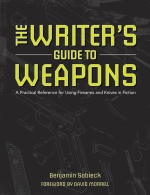
What’s the difference between fully automatic, semi-automatic and automatic firearms? And who left this pile of guns here? (Shutterstock photo)
TLDR: When writing, clarify whether the gun in the story is “semi-automatic” or “fully automatic” upon first reference, then use “automatic” as shorthand. There is a functional difference that could affect the plot.
If learning about firearms feels like an exhausting exercise in vocabulary, thank you for reading this blog! That’s exactly what a lot of it is, but that doesn’t mean vocab is any less important. Plots hinge on characters using firearms. The words you use indicate functionality, which impacts what happens in the story. That goes double in the often conflated usage of “automatic” firearms.
Here’s how to get it right.
Semi- or Fully? Or Just Automatic?
Let’s start out with some basic terminology.
An automatic firearm is a gun that reloads itself without manual assistance from the operator. The gun goes bang, and various mechanisms inside of the firearm capture force from the recoil to automatically reload. An example is illustrated in this video by Youtuber Skallagrim. (Or click here for a cool GIF.)
Automatic firearm type include rifles, shotguns and pistols (but not revolvers). That doesn’t mean every rifle, shotgun and pistol is an automatic. It just means there are automatic versions of those firearm types.
In general, automatic firearms are divided into two categories: semi-automatics and fully automatics. There are variants within those categories, but those aren’t important for this post.

Semi-automatics fire once per pull of the trigger.
Fully automatics can fire more than once per pull of the trigger.
This may not seem like a big difference, but it’s enormous on the mechanical and legal front. For instance, semi-automatics are widely available to U.S. civilians. Fully automatics are not.
Here’s Where It Gets Confusing
Writers trip up when they don’t specify which type of automatic firearm is present in the story. They’ll use “Biff fired an automatic firearm” in ways that make sense if it’s a semi-auto in one chapter but a full auto in another. Muddying the waters are nicknames and shorthand descriptions they encounter while researching.
As an example, one writer (I’m still not breaking my golden rule and naming the person, though) used “automatic pistol” in a story. In one part, the “automatic” features served to make a point about a particular gun law, implying the firearm was fully automatic (fired more than one shot per trigger pull).
However, in another point in the story, the pistol functioned similarly to a semi-automatic, which differed from its original depiction. That is, unless the writer meant semi-automatic in the first place, which would’ve changed a key plot point.
See what I mean about it getting confusing?
The Takeaway for Writing Fiction
The key is consistency. First, figure out if the character is using a semi-automatic or fully automatic firearm. State that upon first reference. After that, it’s appropriate to use “automatic firearm” as shorthand.
If you find you’re confusing yourself, you’re probably confusing the reader. Stop, ask someone (maybe even send me a tweet!), consult this book and/or start again.
Further Reading
If this is a topic that interests you, check out these other posts:
- What’s the Difference? Machine Gun vs. Submachine Gun
- Assault Weapons vs. Assault Rifles vs. What You’ve Heard
- What is an AR-15?
Get the Book
 The Writer’s Guide to Weapons: A Practical Reference for Using Firearms and Knives in Fiction (Writer’s Digest Books) distills complex weapons topics into easy-to-understand concepts for fiction writers. Pick up a print or digital copy from these fine retailers:
The Writer’s Guide to Weapons: A Practical Reference for Using Firearms and Knives in Fiction (Writer’s Digest Books) distills complex weapons topics into easy-to-understand concepts for fiction writers. Pick up a print or digital copy from these fine retailers:
M249 SAW. Squad automatic weapon why not squad full automatic weapon?
LikeLike